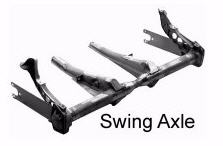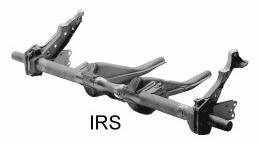|
Is a Swing Axle
or IRS Better?

Swing Axle Pluses
(Through
'68 they used swing axle rear suspension)
The
swing-axle suspension offers
lower unstrung weight, which is the weight that "bounces" with the
wheel. This lets the tires follow road surface more closely. This
results in less inertia for the shock absorbers to overcome.
The swing-axle
suspension also has fewer parts. Fewer parts mean fewer parts to
break. There's an economic consideration too. The swing-axle
suspension generally costs less because of the old rule of supply
and demand. More are available.
Swing Axle Minuses
Swing axles pivot only at the gearbox.
The swing- axle is
'fixed' at the wheel (that is, it is not able to flex up or down),
but is able to move up and down at the transmission end. It required
the rear wheels to move in an arc, rather than vertically, when
hitting bumps. in some cars (beetles and corvairs and some early
porsches), it could cause the wheel to tuck under the car during
high speed cornering.
The swing-axle suffers
from excessive camber change. To restrict positive camber at full
rebound special spring plate stops are needed to limit rebound
travel.
The IRS

(Independent
Rear Suspension. A form of rear suspension that allows the rear
wheels to move vertically up and down, independently of each other,
to compensate for bumps and road surfaces. uses a double-jointed
rear axle, with cv-joints at each end. )
From '69 on, they used
IRS
If you could ask a
suspension engineer, he'd tell you the IRS, or semi-trailing arm
rear suspension, is the better. The IRS can be modified for ground
clearance and wheel travel without the extreme camber change of the
swing-axle.
IRS Minuses
The
IRS suspension has its drawbacks. Because the system has more parts
to wear out or fail.
wear out or fail
|